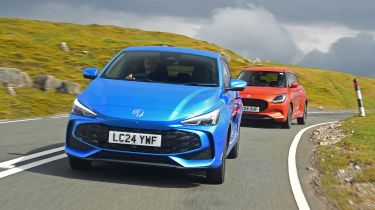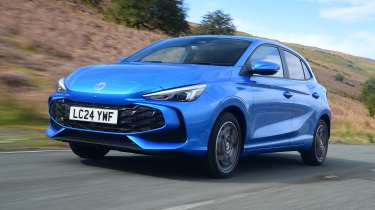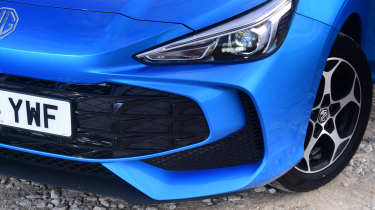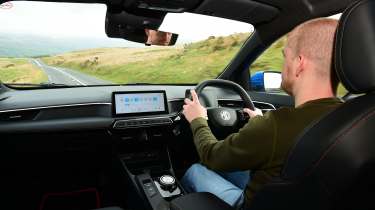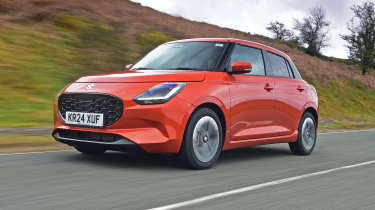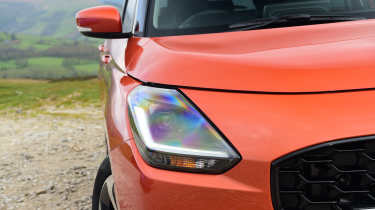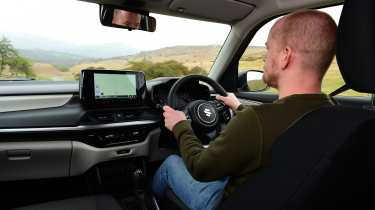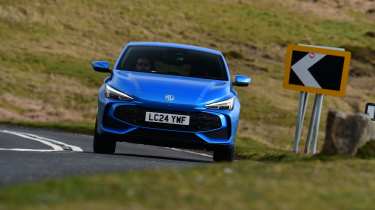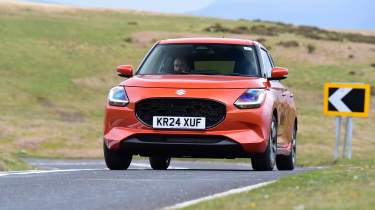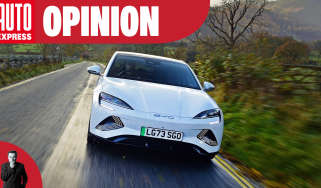Suzuki Swift vs MG3 2024 twin test: bargain small car battle
The Ford Fiesta’s demise has left a yawning chasm in the supermini class. Can the new MG3 and Suzuki Swift fill it?
There's been a lot of doom and gloom about the death of the supermini. Ever since Ford decided to shelve the Fiesta after 47 years, there has been a cloud hanging over the small car class – if one of the world’s biggest brands can’t make such a car work, what hope is there for its rivals?
To some manufacturers, however, that gap in the market could be seen as a golden opportunity. That chance becomes even greater in the budget segment of the class, because while margins are slim, so is customer choice.
Here, we have two cars that aim to fill the void left by the Fiesta. First up is the MG3. The outgoing version has been in service for some time but, decent chassis aside, offers very little else. However this all-new model has lots of fascinating tech under the skin, including a full-hybrid powertrain.
Then there’s the Suzuki Swift. It’s a car which has traditionally punched above its weight, courtesy of its engaging driving dynamics and low running costs.
Can it bring anything else to the mix that will help it to compete with the class leaders? And can the MG transform itself from an also-ran into a model that can hold off the best supermini competition?
| Suzuki Swift 1.2 MHEV Ultra | MG3 Hybrid+ Trophy | |
| Price: | £19,799 | £20,495 |
| Powertrain: | 1.2-litre 3cyl MHEV, 81bhp, front-wheel drive | 1.5-litre 4cyl plus e-motor, 191bhp, front-wheel drive |
| 0-62mph: | 12.5 seconds | 8.0 seconds |
| Test efficiency: | 50.1mpg/12.2mpl | 55.4mpg/11.0mpl |
| CO2: | 99g/km | 100g/km |
MG3
The MG3 Hybrid+ is more expensive than the car it replaces, with the base SE costing £18,495 and this top-spec Trophy commanding a £2k premium. But even before you drive it, the on-paper changes start to justify the price hike.
Tech highlights
The previous MG3 is very cheap (it’s still available until stocks run out), but not particularly cheerful – the likes of the Dacia Sandero and Citroen C3 are much better options. But this all-new model competes in a different area of the class.
Used - available now

2024 Volkswagen
Golf
48,352 milesAutomaticDiesel2.0L
Cash £19,700
2020 MINI
Countryman
46,628 milesAutomaticPetrol1.5L
Cash £10,000
2023 Land Rover
Discovery Sport
40,215 milesAutomaticPetrol1.5L
Cash £24,230
2018 MG
ZS
19,824 milesAutomaticPetrol1.0L
Cash £14,103The leap up in tech is vast, and nowhere is that more obvious than under the bonnet. The full-hybrid powertrain uses a 102bhp 1.5-litre petrol engine that’s a development of the unit from the old car, but everything surrounding it is completely new. It’s called Hybrid+ because the electrical side of the layout forms a more significant portion of the car’s overall output – an approach unlike any of its rivals. The e-motor makes 134bhp and 250Nm on its own, and draws energy from a 1.83kWh battery – also larger than any of its competitors – which is located under the rear seats.
For the most part the petrol engine powers a generator that tops up the battery, but when full performance is required, it drives the front wheels alongside the electric motor to deliver a maximum combined output of 192bhp and 425Nm. Drive is sent to the front wheels via a three-speed automatic gearbox.
Safety: Euro NCAP hasn’t put the MG3 through its crash-test paces yet, but its bigger brother, the MG4, achieved a maximum five-star rating, so MG will be aiming for a similar result here. Both of the car’s trims get adaptive cruise control with lane centering as standard.
On the road
From behind the wheel, the MG3 is by far the most polished product the company has produced. Ride, handling, performance and refinement are all up there with the best in the class.
Around town: With plenty of power from the electric motor, the MG3 feels more like an EV than a hybrid at low speeds. Acceleration is lively and the throttle response is instant and enthusiastic.
One small gripe is that the throttle can be hard to modulate at very low speeds, so parking manoeuvres tend to be slightly jerky. At least the bright and clear 360-degree camera makes it easy to see what’s around you when reversing into a space. The ride is composed and suspension knocks are well isolated from the cabin.
A & B-roads: Find a twisty road and the MG is among the more enjoyable cars to drive in this class. The overall set-up is a little softer than average, which not only helps with comfort, but allows you to approach the MG3’s limits of grip with plenty of confidence.
What feels like a slightly nose-heavy balance can be played with through throttle inputs, but it always remains just on the right side of reassuring to be fun for a wide range of drivers. That lively EV-like performance gets even more muscular when the petrol engine starts to drive the wheels – the 0-62mph dash is shrugged off in eight seconds flat, but the response is occasionally laggy.
Motorway: That hesitancy can mean that overtakes require more forward planning than in an EV, but otherwise the MG3 is very accomplished when you up the pace, with a soothing ride, minimal wind noise and great high-speed stability. Adaptive cruise control with steering assist makes long trips less draining.
Ownership
Climb aboard the MG3, and you’re greeted by a cabin that on first inspection doesn’t betray the car’s budget origins. It doesn’t quite have the quality of finish or contemporary design of a Skoda Fabia or Peugeot 208, but the layout is neat and stylish enough. While there are some hard plastics around, that’s not unusual for a supermini, and padded materials on the armrests, and a steering wheel that’s pleasant to hold make the most common touchpoints feel fine. There is
one area that’s a let-down and that’s the centre console; the sliding tray that covers the cup-holders feels loose and flimsy.
One other feature which gives off an impression of cost cutting is the adjustable steering column. It only adjusts for rake not reach, so despite a decent range of adjustment on the driver’s seat, it can be a little difficult to find your ideal driving position. Visibility is reasonable overall, but a narrow back window combined with larger headrests on the outer rear seats means the view through the rear-view mirror is a little obstructed.
MG offers buyers an excellent seven-year/80,000-mile warranty as standard. Based on owner feedback from our annual Driver Power survey, that’s a blessing, because MG finished 32nd out of 32 manufacturers, with roughly a third of owners experiencing a fault of some kind within the first year of ownership. Whether the brand’s improvements in every other aspect of its cars also relates to reliability remains to be seen.
Storage: A large central cubby under the main dash area is large enough for the bulkiest of smartphones, while a couple of USB ports let you top up your devices on the move. Door bins both front and rear are fairly generous, and the area between the front seats has removable plastic pieces that can form different partitions in order to secure items of a range of sizes.
Practicality
The MG3’s interior and boot space are about average for the class: not outstanding, but not bad either.
Rear Space: Settle into the back seats and you’ll first notice the sculpted shape of the outer chairs makes them really quite comfortable by supermini standards. Kneeroom is fine and there’s loads of space for feet beneath the front seats, but taller passengers might find rivals such as the Skoda Fabia a better bet when it comes to headroom.
Boot: The MG3’s 293-litre boot is competitive with other superminis fitted with a full-hybrid system, if a little short of the non-hybrid best. It’s reasonably roomy, but the load lip is quite high, which makes it a little harder to place heavy items inside than with other alternatives. The folding seat back doesn’t split, which limits its versatility.
Which to buy
Which version we’d choose…
- Engines: There’s just the solitary hybrid powertrain to choose from for the moment. However, later in the year, a pure-petrol model with a manual gearbox will be added – expect this to start from around £16,000. MG has ruled out a full-EV version, though.
- Trim: SE comes with air-conditioning, adaptive cruise, satellite navigation and a reversing camera, while the Trophy adds LED headlights, keyless entry, blind-spot detection, a 360-degree camera, plus a heated steering wheel and front seats partially trimmed in synthetic leather.
- Our choice: We’d keep costs to an absolute minimum by picking the base SE.
Suzuki Swift
At £19,799, the Suzuki Swift manages to undercut the MG we’re testing here by £696. That’s not a huge amount, but look at the details and the differences begin to reveal themselves.
Tech highlights
Compared with the seemingly complex powertrain used by the MG, Suzuki has gone for a much simpler approach. There’s no big battery or electric motor here; instead there’s a 12-volt mild-hybrid system, which features an integrated starter-generator unit. It’s not one that adds outright power – it produces just 3.1bhp – but the 60Nm of torque helps to take load off the petrol engine. The entire MHEV system weighs 7kg, and light weight is a virtue of the Swift. The most intriguing stat is the mass of these two cars: the 949kg Suzuki is a full 349kg lighter than the MG.
The petrol side of the powertrain uses a 1.2-litre three-cylinder engine, while the maximum output is 81bhp and 112Nm, which is sent to the front wheels via a five-speed manual gearbox.
The suspension set-up is a development of what was fitted to the previous Swift; the front stabiliser is thicker and the mounts have been revised, both done with the aim of improving steering feel (a detail which has also received attention courtesy of a revised power-steering control unit) and increasing stability. At the back, the suspension has greater travel than before to improve its ability to absorb bumps. The brake servo has also been revised to deliver better feedback.
Safety: It’s too early for an NCAP rating for the Swift, but there’s new tech available. Blind-spot detection is fitted as standard to all trims, and the emergency braking system has been revised with a new radar sensor that’s better at detecting pedestrians and other vehicles, especially at night.
On the road
While there’s nothing remarkable about the Suzuki’s powertrain, the chassis is terrific, helping the Swift to handle very well indeed.
Around town: The Swift’s petrol engine works far more often than the MG’s, but when it does cut in and out courtesy of the mild-hybrid system, the process is impressively smooth. As with many three-cylinder engines, the Suzuki’s 1.2-litre unit gives off a subtle vibration, but it’s not unpleasant because the noise it makes is fairly muted.
The major controls are light, even if the gearlever is occasionally notchy. Tiny dimensions make the car a doddle to manoeuvre around town.
A & B-roads: With the departure of the Fiesta from this class, there are very few superminis that can put a smile on your face – but the new Swift is one of the most engaging cars in its class to drive. The key to its fun is that tiny kerbweight; none of its rivals feel as agile in corners. This is no hot hatch, and yet the Suzuki darts from one turn to the next, with lots of grip in reserve.
It’s helped by steering that is vastly improved over the slightly odd sensation of its predecessor’s. The new set-up feels more precise and much more naturally weighted than the MG’s rack.
It even makes the Swift’s leisurely 0-62mph time of 12.5 seconds seem less of a hardship, because of the enjoyment gained in the process of maintaining momentum.
Motorway: At higher speeds it’s clear that some of the Suzuki’s weight saving has come at the expense of soundproofing. Both road and wind noise are noticeably louder here than in the MG, which does make the Suzuki a little more tiring on a long trip. Ride comfort isn’t quite as smooth as the MG3’s, with some fidget felt at all speeds.
Ownership
Unlike the MG, which looks completely different to its predecessor, the Swift is instantly familiar. The fundamental details of the old car remain, even if they’ve moved around a bit to deliver a more substantial look.
Both cars have cabins built down to a price, but the Swift’s gives the game away more. Light-coloured plastics break up the dark grey, but the fake metallic elements look and feel cheap – and with a large section of it on the steering wheel, it’s always within touching distance. We’re fans of the simple physical climate controls, though, and the dials are clear and easy to read, which makes it easier to forget that its similarly priced rival has fully digital instruments.
Visibility is good, thanks to large windows. Passengers in the back will feel a little short changed, though, because the doors are exclusively made of hard, black plastic, the seats feel very flat and unsupportive after those in the MG, and there isn’t a USB port to charge devices.
Suzuki finished in 22nd place in our 2023 Driver Power satisfaction survey, and owners who took part weren’t blown away with their ownership experiences, disappointed most by their cars’ interior quality, safety features and boot space.
However, just eight per cent of those owners experienced a fault with their cars – comfortably the lowest number of any of the 32 manufacturers surveyed. One year of breakdown cover is offered from new, which is the same as the MG.
Storage: The front door bins are reasonably slim, but they have an area at their leading edge shaped to hold a drinks bottle, which makes them a useful cubby. The two cup-holders in the centre of the dash are a little too shallow, while a third one sits behind the handbrake for rear-seat passengers. The smartphone cubby and the glovebox are a
little too small to be useful, though.
Practicality
The Swift is a more compact car than its rival, so Suzuki has done a reasonable job of accommodating passengers. But it does come at the expense of boot capacity.
Rear Space: Both head and legroom are reasonable in the back of the Swift, but the seat base feels quite close to the floor, which can force the thighs of taller passengers upwards with less support. Foot space under the front seat is limited, which makes it feel cramped. The cabin is narrow but the centre seat is quite soft, and although there’s a hump in the floor, it’s fairly low.
Boot: At 265 litres, the Swift’s load space is some way below the class best, including the merely average volume of the MG3 here. There’s a minimal amount of space under the boot floor, but on the plus side, the lip height is lower than that of the MG, which makes loading easier.
Which to buy
Which version we’d choose…
- Engines: The mild-hybrid powertrain is available in a couple of variants. The five-speed manual model is the cheapest, but there are also CVT automatic and four-wheel-drive manual options. The latter is only available on the top trim; both cost £1,250 more than the base variant.
- Trim: Entry level Motion is well equipped, with LED headlights, 16-inch alloys, rear parking sensors, a reversing camera, adaptive cruise control and lane-keep assist. Ultra adds climate control, electrically folding door mirrors and one or two minor extras for £1,100.
- Our choice: Much like the MG, we’d stick with the well equipped base model.
Results
Which car comes out on top?
Winner: MG3
The MG3 has the talent to overcome the Suzuki Swift in this contest, but in reality, it wouldn’t have mattered which supermini it was paired up with – the newcomer would have come out on top regardless.
Its performance is class leading, while the ride, handling, efficiency and equipment levels are all a match for cars that cost thousands of pounds more to buy. And it’s that value angle which makes the MG3 such a strong prospect; it’s an area of the new-car market where that counts for more than in any other.
| Pros | Cons |
| Class-leading performance | Occasionally laggy hybrid |
| Ride and handling | Artificial steering feel |
| Refinement | No steering reach adjustment |
| Bargain price | Patchy interior quality |
Runner-up: Suzuki Swift
The new Swift is a very strong supermini contender. Its simplicity and light weight make it both cheap to run and fun to drive, while it’s fairly spacious inside and the finance rates (especially for leasing) really are fantastic.
You can trace similarities back to its predecessor, but it has improved in almost every area. That alone would be enough to give it a fighting chance against many rivals, but it isn’t quite enough against MG’s best model yet.
| Pros | Cons |
| Great fun to drive | Average performance |
| Low running costs | Noisy at motorway speeds |
| Smooth MHEV system | Cheap-feeling cabin |
| Strong equipment levels | Small boot |
Rivals and other options
The Scala wins our test, but what else is out there?
- Same class: Renault Clio
- Same money: Dacia Sandero
- Used: Skoda Fabia
- Used: Toyota Corolla
- Coming soon: Citroen C3
The great debate
The Auto Express team have their say…
John McIlroy, editor-at-large: “Electric cars are smoother, quieter and quicker than their internal-combustion counterparts, so to base the MG3’s hybrid system around that – using the petrol engine as little more than a range extender – is an approach that more firms should consider.”
Richard Ingram, deputy editor: “The MG3 is ideal for those not quite ready to make the jump to an EV, but there are many electric models going on sale soon – and existing EVs getting discounted more by the month – that come close to the MG’s price. Take the electric version of the new Citroen C3, for example.”
Dawn Grant, picture editor: “MG has released this car at the perfect moment. Not only has the Ford Fiesta departed the scene, but as profits continue to squeeze, some other brands might also decide that superminis are no longer on the agenda, which could see the brand capture an even bigger market share.”
Jordan Katsianis, senior staff writer: “It didn’t come out on top here, but we need more cars like the Suzuki Swift. It proves that over-complicated hybrid systems aren’t necessary to deliver fuel efficiency if you keep the weight low and the dimensions small. A trade-off of that simplicity is that it’s great to drive, too.”
Dean Gibson, senior test editor: “When Ford canned the Fiesta, many buyers felt forced to move to the more expensive Puma. Now that two more genuinely competent alternatives have arrived, it’ll be interesting to see whether the Puma’s success continues at its current rate, or if sales begin to slow.”
Which would you buy? Let us know in the comments section below…
Specs and prices
| MG3 Hybrid+ Trophy | Suzuki Swift 1.2 Mild Hybrid Ultra | |
| On the road price/total as tested: | £20,495/£21,040 | £19,799/£20,399 |
| Residual value (after 3yrs/36,000): | £9,950 (48.55%) | £10,325 (52.15%) |
| Depreciation: | £10,545 | £9,474 |
| Annual tax liability std/higher rate: | £1,022/£2,044 | £939.79/£1,879.60 |
| Annual fuel cost (10k/20k miles): | £1,227 (£2,454) | £1,357 (£2,713) |
| Ins. group/quote/VED: | 24/£549/£180 | 27/£489/£180 |
| Length/wheelbase: | 4,113/2,570mm | 3,860/2,450mm |
| Height/width: | 1,502/1,797mm | 1,495/1,735mm |
| Engine: | 4cyl in HEV/1,498cc | 3cyl in MHEV/1,197cc |
| Peak power: | 134bhp e-motor, 1.83kWh battery | 3bhp ISG, li-ion battery |
| Peak torque: | 191bhp | 81bhp |
| Transmission: | 425Nm | 112Nm |
| Fuel tank capacity/spare wheel | 36 litres/repair kit | 37 litres/repair kit |
| Boot capacity (seats up/down) | 293/983 litres | 265/589 litres |
| Kerbweight/payload/towing weight | 1,298/468/500kg | 949/416/1,000kg |
| Turning circle | 10.5 metres | 9.6 metres |
| Basic warranty/recovery | 7yrs (80k)/1 yr | 3 yrs (60,000)/1 yr |
| Driver Power manufacturer position | 32nd | 22nd |
| Euro NCAP: Adult/child/ped./assist/stars | N/A | N/A |
| 0-62mph/top speed | 8.0 seconds/106mph | 12/5 seconds/103mph |
| Test economy/range | 55.4/439 | 50.1/408 |
| WLTP combined | 64.2mpg | 64.2mpg |
| Actual/Claimed CO2 | 118/100g/km | 130/99gkm |
| Number of airbags/Isofix points | Six/two | Six/two |
| Parking sensors/camera | Rear/360 | Rear/yes |
| Lane-keep assist/blindspot/AEB | Yes/yes/yes | Yes/yes/yes |
| Climate control/adaptive cruise | Two-zone/yes | Two-zone/yes |
| Leather/heated seats/wheel | No/yes/yes | No/yes/no |
| Metallic paint/LED lights | £545/yes | £0/yes |
| Keyless entry & go/powered tailgate | Yes/no | Yes/no |
| Sat-nav/digital dashboard/USBs | Yes/yes/four | Yes/no/three |
| Online services/wireless charging | Yes/no | Yes/no |
| Apple CarPlay/Android Auto | Yes/yes | Wireless/wireless |

